Global Health: Sanitation, Drinking-water and Hygiene in Ghana
VerifiedAdded on 2023/05/28
|17
|6048
|147
Report
AI Summary
This report provides an in-depth analysis of sanitation, drinking water, and hygiene as a critical global health issue, specifically focusing on the situation in Ghana. The study highlights that a significant portion of the Ghanaian population lacks access to safe water and sanitation, leading to increased vulnerability to waterborne diseases. The report explores the multifaceted impacts of this crisis, including the spread of diseases like cholera and diarrhea, and the negative effects on women, children, and the economy. It examines the role of various factors such as environment, economic, and cultural aspects in exacerbating these health issues. Furthermore, it discusses the implications of Sustainable Development Goal 6 (SDG 6) and other international policies, evaluating their effectiveness in addressing the global water crisis. The report concludes with recommendations for improving water management, promoting community participation, and enhancing access to safe water and sanitation facilities in Ghana, emphasizing the need for comprehensive strategies to combat the challenges and improve public health.
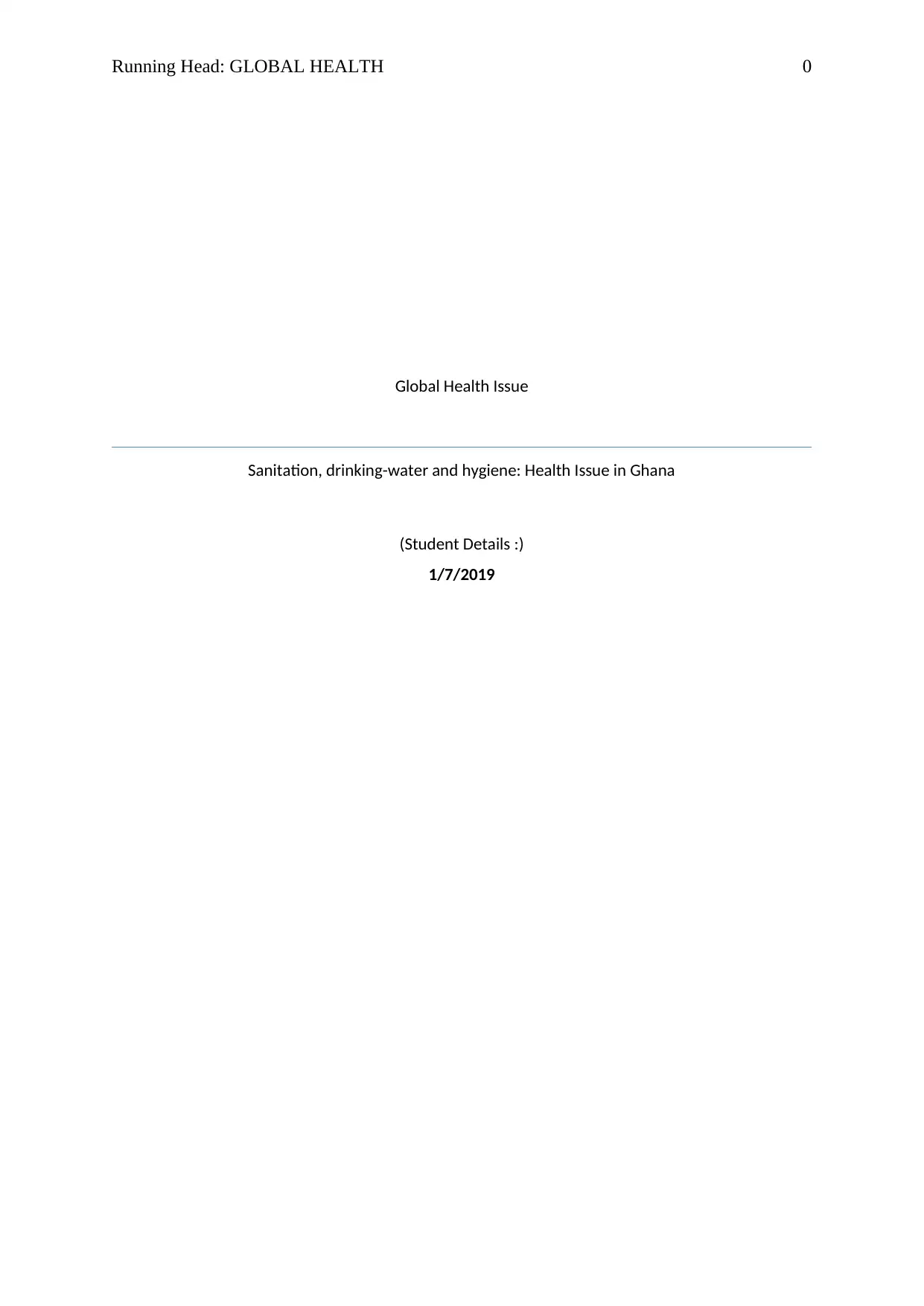
Running Head: GLOBAL HEALTH 0
Global Health Issue
Sanitation, drinking-water and hygiene: Health Issue in Ghana
(Student Details :)
1/7/2019
Global Health Issue
Sanitation, drinking-water and hygiene: Health Issue in Ghana
(Student Details :)
1/7/2019
Paraphrase This Document
Need a fresh take? Get an instant paraphrase of this document with our AI Paraphraser
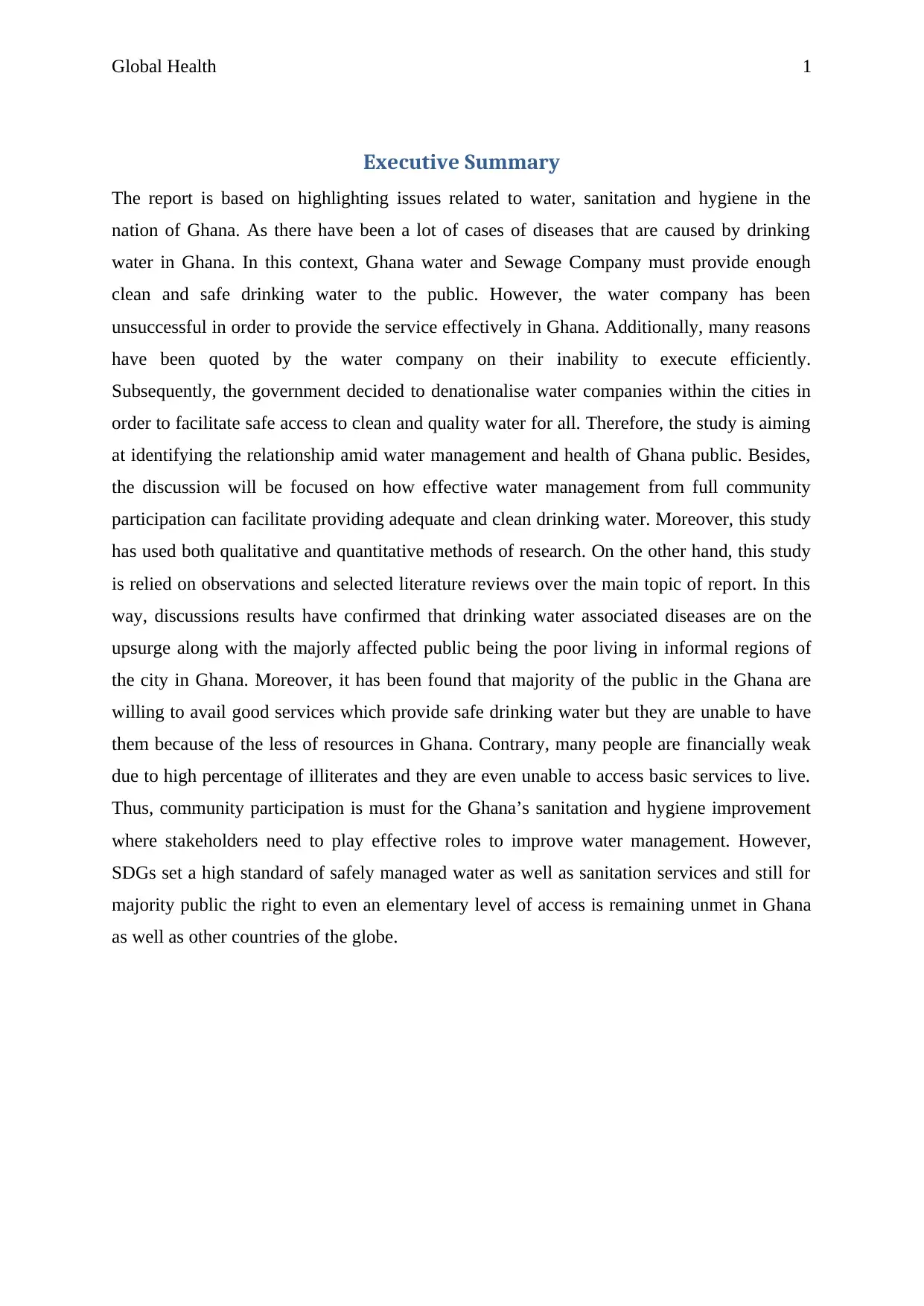
Global Health 1
Executive Summary
The report is based on highlighting issues related to water, sanitation and hygiene in the
nation of Ghana. As there have been a lot of cases of diseases that are caused by drinking
water in Ghana. In this context, Ghana water and Sewage Company must provide enough
clean and safe drinking water to the public. However, the water company has been
unsuccessful in order to provide the service effectively in Ghana. Additionally, many reasons
have been quoted by the water company on their inability to execute efficiently.
Subsequently, the government decided to denationalise water companies within the cities in
order to facilitate safe access to clean and quality water for all. Therefore, the study is aiming
at identifying the relationship amid water management and health of Ghana public. Besides,
the discussion will be focused on how effective water management from full community
participation can facilitate providing adequate and clean drinking water. Moreover, this study
has used both qualitative and quantitative methods of research. On the other hand, this study
is relied on observations and selected literature reviews over the main topic of report. In this
way, discussions results have confirmed that drinking water associated diseases are on the
upsurge along with the majorly affected public being the poor living in informal regions of
the city in Ghana. Moreover, it has been found that majority of the public in the Ghana are
willing to avail good services which provide safe drinking water but they are unable to have
them because of the less of resources in Ghana. Contrary, many people are financially weak
due to high percentage of illiterates and they are even unable to access basic services to live.
Thus, community participation is must for the Ghana’s sanitation and hygiene improvement
where stakeholders need to play effective roles to improve water management. However,
SDGs set a high standard of safely managed water as well as sanitation services and still for
majority public the right to even an elementary level of access is remaining unmet in Ghana
as well as other countries of the globe.
Executive Summary
The report is based on highlighting issues related to water, sanitation and hygiene in the
nation of Ghana. As there have been a lot of cases of diseases that are caused by drinking
water in Ghana. In this context, Ghana water and Sewage Company must provide enough
clean and safe drinking water to the public. However, the water company has been
unsuccessful in order to provide the service effectively in Ghana. Additionally, many reasons
have been quoted by the water company on their inability to execute efficiently.
Subsequently, the government decided to denationalise water companies within the cities in
order to facilitate safe access to clean and quality water for all. Therefore, the study is aiming
at identifying the relationship amid water management and health of Ghana public. Besides,
the discussion will be focused on how effective water management from full community
participation can facilitate providing adequate and clean drinking water. Moreover, this study
has used both qualitative and quantitative methods of research. On the other hand, this study
is relied on observations and selected literature reviews over the main topic of report. In this
way, discussions results have confirmed that drinking water associated diseases are on the
upsurge along with the majorly affected public being the poor living in informal regions of
the city in Ghana. Moreover, it has been found that majority of the public in the Ghana are
willing to avail good services which provide safe drinking water but they are unable to have
them because of the less of resources in Ghana. Contrary, many people are financially weak
due to high percentage of illiterates and they are even unable to access basic services to live.
Thus, community participation is must for the Ghana’s sanitation and hygiene improvement
where stakeholders need to play effective roles to improve water management. However,
SDGs set a high standard of safely managed water as well as sanitation services and still for
majority public the right to even an elementary level of access is remaining unmet in Ghana
as well as other countries of the globe.
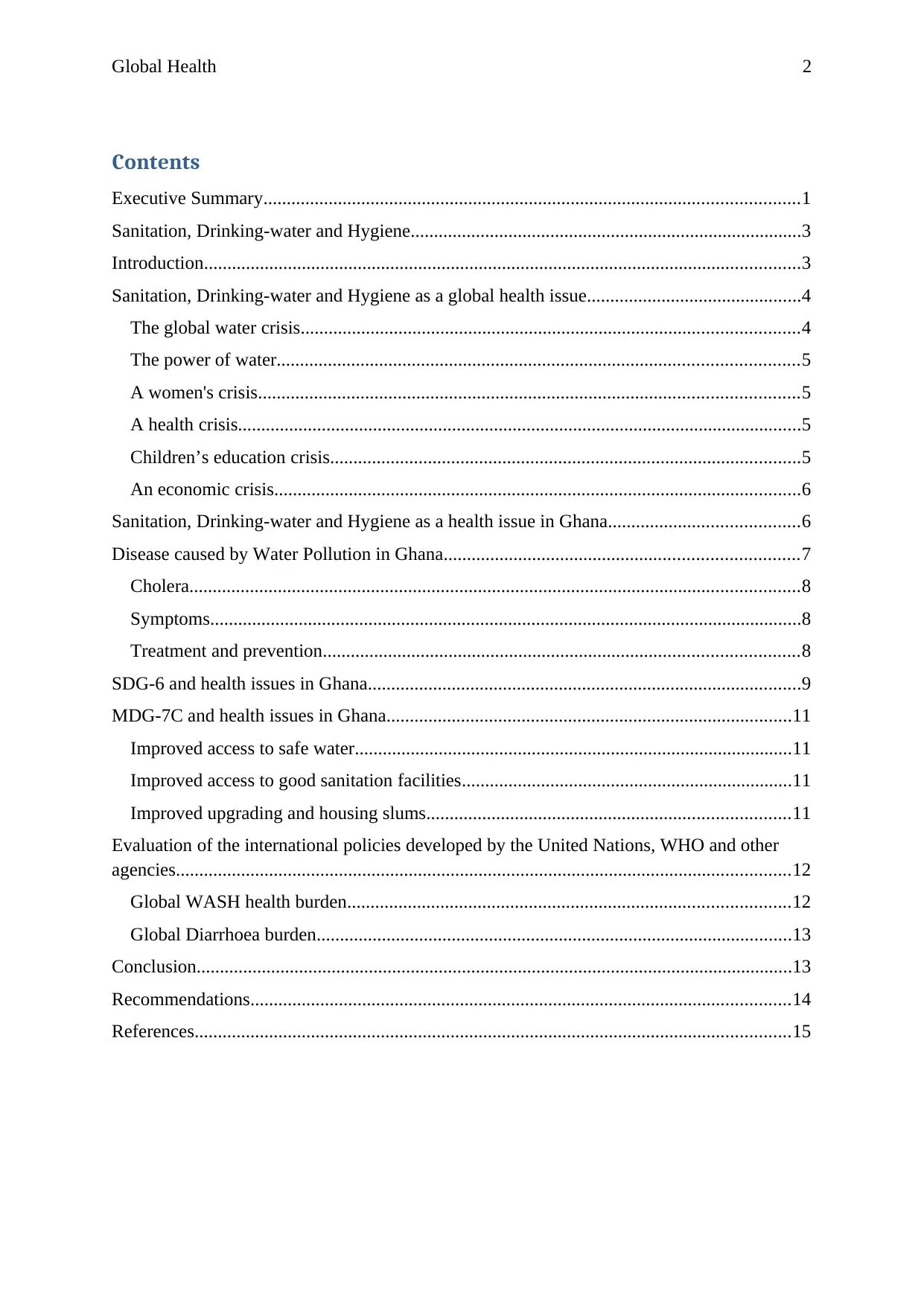
Global Health 2
Contents
Executive Summary...................................................................................................................1
Sanitation, Drinking-water and Hygiene....................................................................................3
Introduction................................................................................................................................3
Sanitation, Drinking-water and Hygiene as a global health issue..............................................4
The global water crisis...........................................................................................................4
The power of water................................................................................................................5
A women's crisis....................................................................................................................5
A health crisis.........................................................................................................................5
Children’s education crisis.....................................................................................................5
An economic crisis.................................................................................................................6
Sanitation, Drinking-water and Hygiene as a health issue in Ghana.........................................6
Disease caused by Water Pollution in Ghana............................................................................7
Cholera...................................................................................................................................8
Symptoms...............................................................................................................................8
Treatment and prevention......................................................................................................8
SDG-6 and health issues in Ghana.............................................................................................9
MDG-7C and health issues in Ghana.......................................................................................11
Improved access to safe water..............................................................................................11
Improved access to good sanitation facilities.......................................................................11
Improved upgrading and housing slums..............................................................................11
Evaluation of the international policies developed by the United Nations, WHO and other
agencies....................................................................................................................................12
Global WASH health burden...............................................................................................12
Global Diarrhoea burden......................................................................................................13
Conclusion................................................................................................................................13
Recommendations....................................................................................................................14
References................................................................................................................................15
Contents
Executive Summary...................................................................................................................1
Sanitation, Drinking-water and Hygiene....................................................................................3
Introduction................................................................................................................................3
Sanitation, Drinking-water and Hygiene as a global health issue..............................................4
The global water crisis...........................................................................................................4
The power of water................................................................................................................5
A women's crisis....................................................................................................................5
A health crisis.........................................................................................................................5
Children’s education crisis.....................................................................................................5
An economic crisis.................................................................................................................6
Sanitation, Drinking-water and Hygiene as a health issue in Ghana.........................................6
Disease caused by Water Pollution in Ghana............................................................................7
Cholera...................................................................................................................................8
Symptoms...............................................................................................................................8
Treatment and prevention......................................................................................................8
SDG-6 and health issues in Ghana.............................................................................................9
MDG-7C and health issues in Ghana.......................................................................................11
Improved access to safe water..............................................................................................11
Improved access to good sanitation facilities.......................................................................11
Improved upgrading and housing slums..............................................................................11
Evaluation of the international policies developed by the United Nations, WHO and other
agencies....................................................................................................................................12
Global WASH health burden...............................................................................................12
Global Diarrhoea burden......................................................................................................13
Conclusion................................................................................................................................13
Recommendations....................................................................................................................14
References................................................................................................................................15
⊘ This is a preview!⊘
Do you want full access?
Subscribe today to unlock all pages.

Trusted by 1+ million students worldwide

Global Health 3
Sanitation, Drinking-water and Hygiene
Introduction
In the nation of Ghana, around 6 million people which are 22 per cent of people of the nation
cannot access daily sanitation and water for the daily needs and this leaves them susceptible
to the water-associated disease and illness (Hanefeld, 2015). Furthermore, 67 per cent of
Ghanaians dearth access to developed sanitation, even without toilet services. Hence, 70 per
cent of total diseases in nation of Ghana are instigated through poor sanitation and unsafe
water (Buse & Hawkes, 2015).
Water, sanitation and hygiene associated diseases are the general public health issues
confronting Ghana as well as several developing countries. Thus the diseases related to water
sanitation in turn add to high risk issues for rest diseases which affect the population growth
directly. Although, a minor success has been established in order to reduce and even we are
nearly eradicating minor water, sanitation-related diseases, yet the threat modelled by this
health issue is still remaining (Commission on Social Determinants of Health, 2008).
Additional to the above mentioned diseases, unclean water sources and poor sanitation are
extremely interrelated with the persistence and spread of diseases like malaria, diarrhoea and
hepatitis. In this context, the estimated about total deaths from malaria in Ghana in the year of
2012 were in between 13, 000 and 22, 000, as well as according to WHO data unhygienic
environments have been associated to 20, 300 deaths in a year (WHO, 2014).
If we will go through the researches, journals, and books for the data representing causes of
these health issues then we will found that there are many factors that are contributing to the
health issues, they are: environment, economic and culture factors. Thus, according to a
report of survey conducted by the IRC Ghana (referred as International Water and Sanitation
Centre), a self-governing global non-profit organisation as well as its partners provides
national access to the basic sanitation which stands at 14 per cent (Skolnik, 2016).
Furthermore, Country Director of the IRC Ghana, who works in the department of safe water
supply, sanitation, and hygiene, recently disclosed that the nation was building slow growth
in attaining set targets for goal-6 of the Sustainable Development Goals (referred as SDGs),
for ensuring water and sanitation for global people by the year 2030 (Water Org, 2018).
Moreover, in order to establish the SDG targets, directional efforts will have to be
Sanitation, Drinking-water and Hygiene
Introduction
In the nation of Ghana, around 6 million people which are 22 per cent of people of the nation
cannot access daily sanitation and water for the daily needs and this leaves them susceptible
to the water-associated disease and illness (Hanefeld, 2015). Furthermore, 67 per cent of
Ghanaians dearth access to developed sanitation, even without toilet services. Hence, 70 per
cent of total diseases in nation of Ghana are instigated through poor sanitation and unsafe
water (Buse & Hawkes, 2015).
Water, sanitation and hygiene associated diseases are the general public health issues
confronting Ghana as well as several developing countries. Thus the diseases related to water
sanitation in turn add to high risk issues for rest diseases which affect the population growth
directly. Although, a minor success has been established in order to reduce and even we are
nearly eradicating minor water, sanitation-related diseases, yet the threat modelled by this
health issue is still remaining (Commission on Social Determinants of Health, 2008).
Additional to the above mentioned diseases, unclean water sources and poor sanitation are
extremely interrelated with the persistence and spread of diseases like malaria, diarrhoea and
hepatitis. In this context, the estimated about total deaths from malaria in Ghana in the year of
2012 were in between 13, 000 and 22, 000, as well as according to WHO data unhygienic
environments have been associated to 20, 300 deaths in a year (WHO, 2014).
If we will go through the researches, journals, and books for the data representing causes of
these health issues then we will found that there are many factors that are contributing to the
health issues, they are: environment, economic and culture factors. Thus, according to a
report of survey conducted by the IRC Ghana (referred as International Water and Sanitation
Centre), a self-governing global non-profit organisation as well as its partners provides
national access to the basic sanitation which stands at 14 per cent (Skolnik, 2016).
Furthermore, Country Director of the IRC Ghana, who works in the department of safe water
supply, sanitation, and hygiene, recently disclosed that the nation was building slow growth
in attaining set targets for goal-6 of the Sustainable Development Goals (referred as SDGs),
for ensuring water and sanitation for global people by the year 2030 (Water Org, 2018).
Moreover, in order to establish the SDG targets, directional efforts will have to be
Paraphrase This Document
Need a fresh take? Get an instant paraphrase of this document with our AI Paraphraser

Global Health 4
augmented, captivating on board all different dimensions of the social, policy, financial,
economic and technological factors of the global health challenge (Water Org, 2018).
Sanitation, Drinking-water and Hygiene as a global health issue
Drinking-water, Sanitation and Hygiene is seen as a critical health issue around the globe in
the last decade and will continue to remain a major one in future also (WHO, 2013). Thus, in
order to understand this issue as a global health issue there are following aspects of water
crisis in the world:
The global water crisis
Presently, 1 out of 9 persons lack access to clean and safe water as well as 1 out of 3 persons
lack access to the basic facility of a toilet. If we want to address this issue and change this
then global public should support Water.org, so that we can help world to put an end to the
water crisis (Water.Org, 2018). This global water crisis will disproportionately distresses
children and women as well as causes harmful diseases and hence hinders economy and
education (United Nations, 2018).
The power of water
As we all know that water covers every aspect of our life hence safe water access and water
sanitation can rapidly convert problems into potential which can empower people with extra
time for their work. Sanitation and water hygiene can also contribute to improved health for
men, women and children around the globe (Balabanova et al., 2010).
A women's crisis
Drinking-water issue is also generating women’s crisis globally as women are excessively
affected by the safe water crisis, because they are more often answerable for accumulating
safe water for the family (Barker, 1995). Moreover, water management for a family takes
time away from school, work and caring for family. Thus, lack of water as well as sanitation
mops women in a round of poverty and it is again a global health issue caused by water
sanitation and hygiene (Barker, 2004).
Thus, for empowering women solving the water crisis globally is critical. On account for
when women will have safe and quick access to water at home, then they can do more than
their traditional roles as well as water collection. Thus, women will have more time to work
augmented, captivating on board all different dimensions of the social, policy, financial,
economic and technological factors of the global health challenge (Water Org, 2018).
Sanitation, Drinking-water and Hygiene as a global health issue
Drinking-water, Sanitation and Hygiene is seen as a critical health issue around the globe in
the last decade and will continue to remain a major one in future also (WHO, 2013). Thus, in
order to understand this issue as a global health issue there are following aspects of water
crisis in the world:
The global water crisis
Presently, 1 out of 9 persons lack access to clean and safe water as well as 1 out of 3 persons
lack access to the basic facility of a toilet. If we want to address this issue and change this
then global public should support Water.org, so that we can help world to put an end to the
water crisis (Water.Org, 2018). This global water crisis will disproportionately distresses
children and women as well as causes harmful diseases and hence hinders economy and
education (United Nations, 2018).
The power of water
As we all know that water covers every aspect of our life hence safe water access and water
sanitation can rapidly convert problems into potential which can empower people with extra
time for their work. Sanitation and water hygiene can also contribute to improved health for
men, women and children around the globe (Balabanova et al., 2010).
A women's crisis
Drinking-water issue is also generating women’s crisis globally as women are excessively
affected by the safe water crisis, because they are more often answerable for accumulating
safe water for the family (Barker, 1995). Moreover, water management for a family takes
time away from school, work and caring for family. Thus, lack of water as well as sanitation
mops women in a round of poverty and it is again a global health issue caused by water
sanitation and hygiene (Barker, 2004).
Thus, for empowering women solving the water crisis globally is critical. On account for
when women will have safe and quick access to water at home, then they can do more than
their traditional roles as well as water collection. Thus, women will have more time to work
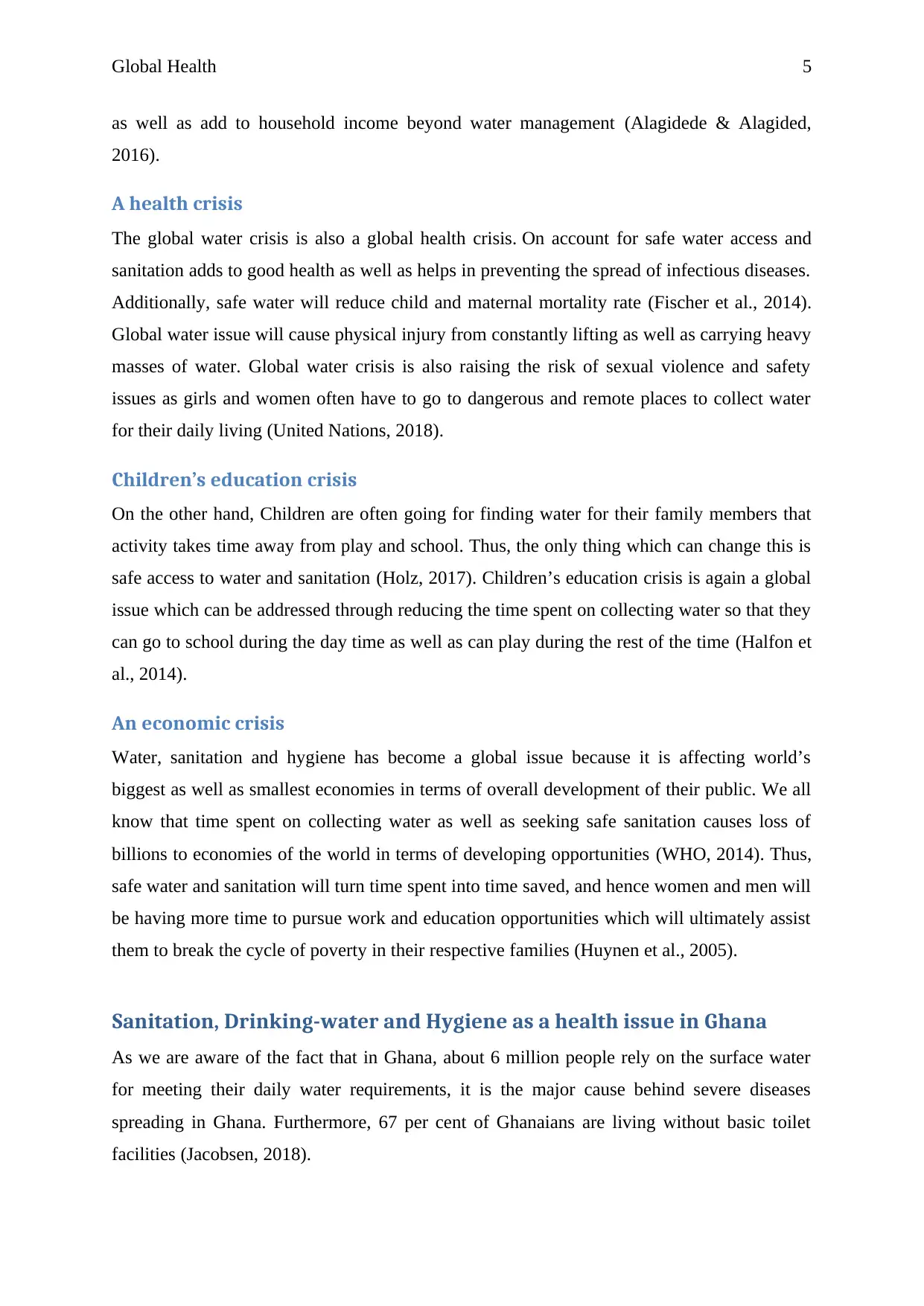
Global Health 5
as well as add to household income beyond water management (Alagidede & Alagided,
2016).
A health crisis
The global water crisis is also a global health crisis. On account for safe water access and
sanitation adds to good health as well as helps in preventing the spread of infectious diseases.
Additionally, safe water will reduce child and maternal mortality rate (Fischer et al., 2014).
Global water issue will cause physical injury from constantly lifting as well as carrying heavy
masses of water. Global water crisis is also raising the risk of sexual violence and safety
issues as girls and women often have to go to dangerous and remote places to collect water
for their daily living (United Nations, 2018).
Children’s education crisis
On the other hand, Children are often going for finding water for their family members that
activity takes time away from play and school. Thus, the only thing which can change this is
safe access to water and sanitation (Holz, 2017). Children’s education crisis is again a global
issue which can be addressed through reducing the time spent on collecting water so that they
can go to school during the day time as well as can play during the rest of the time (Halfon et
al., 2014).
An economic crisis
Water, sanitation and hygiene has become a global issue because it is affecting world’s
biggest as well as smallest economies in terms of overall development of their public. We all
know that time spent on collecting water as well as seeking safe sanitation causes loss of
billions to economies of the world in terms of developing opportunities (WHO, 2014). Thus,
safe water and sanitation will turn time spent into time saved, and hence women and men will
be having more time to pursue work and education opportunities which will ultimately assist
them to break the cycle of poverty in their respective families (Huynen et al., 2005).
Sanitation, Drinking-water and Hygiene as a health issue in Ghana
As we are aware of the fact that in Ghana, about 6 million people rely on the surface water
for meeting their daily water requirements, it is the major cause behind severe diseases
spreading in Ghana. Furthermore, 67 per cent of Ghanaians are living without basic toilet
facilities (Jacobsen, 2018).
as well as add to household income beyond water management (Alagidede & Alagided,
2016).
A health crisis
The global water crisis is also a global health crisis. On account for safe water access and
sanitation adds to good health as well as helps in preventing the spread of infectious diseases.
Additionally, safe water will reduce child and maternal mortality rate (Fischer et al., 2014).
Global water issue will cause physical injury from constantly lifting as well as carrying heavy
masses of water. Global water crisis is also raising the risk of sexual violence and safety
issues as girls and women often have to go to dangerous and remote places to collect water
for their daily living (United Nations, 2018).
Children’s education crisis
On the other hand, Children are often going for finding water for their family members that
activity takes time away from play and school. Thus, the only thing which can change this is
safe access to water and sanitation (Holz, 2017). Children’s education crisis is again a global
issue which can be addressed through reducing the time spent on collecting water so that they
can go to school during the day time as well as can play during the rest of the time (Halfon et
al., 2014).
An economic crisis
Water, sanitation and hygiene has become a global issue because it is affecting world’s
biggest as well as smallest economies in terms of overall development of their public. We all
know that time spent on collecting water as well as seeking safe sanitation causes loss of
billions to economies of the world in terms of developing opportunities (WHO, 2014). Thus,
safe water and sanitation will turn time spent into time saved, and hence women and men will
be having more time to pursue work and education opportunities which will ultimately assist
them to break the cycle of poverty in their respective families (Huynen et al., 2005).
Sanitation, Drinking-water and Hygiene as a health issue in Ghana
As we are aware of the fact that in Ghana, about 6 million people rely on the surface water
for meeting their daily water requirements, it is the major cause behind severe diseases
spreading in Ghana. Furthermore, 67 per cent of Ghanaians are living without basic toilet
facilities (Jacobsen, 2018).
⊘ This is a preview!⊘
Do you want full access?
Subscribe today to unlock all pages.

Trusted by 1+ million students worldwide

Global Health 6
The mainstream of households is not able to access safe water as well as sanitation which
cause lack of upfront funds required to capitalize in their own problems’ solutions.
Subsequently, the people who are living in critical poverty often spend up to 10 times more
for per litre of water services while dealing with private vendors than middle-class colleagues
who are given piped water services (Mccracksen & Phillips, 2017). Thus, these high water
costs can easily be reduced through funds in developed household water resources like
rainwater harvesting equipment, connections, wells and latrines. Regrettably, the above
solution needs up-front investments which are unrealistic to be implemented without an
effective access to financing and investments (Water Org, 2018). Moreover, safe, clean water
and decent environmental sanitation all are essentials for a child survival. Thus, enhanced
access to clean water and sanitation will further reduce infant mortality rates as well as
improve maternal health of the women of Ghana (Water Org, 2018).
However, Ghana is at an edge of accomplishing the Millennium Development Goal (MDG)-7
which is based on clean drinking water, yet the above can barely be declare of sanitation
(United Nations Development Programme, 2015). Besides, numerous studies as well as
reports have recognized that children of Ghana are critically affected through waterborne
diseases like dysentery, diarrhoea, cholera and typhoid fever those are often spread majorly
because of the utilisation of unsafe and polluted water (World Health Organization, 2017).
The World Health Organization (referred as WHO) also estimated that 50 % of malnutrition
is related with recurrent intestinal worm infections or diarrhoea caused by unsafe water,
inadequate sanitation as well as poor hygiene (Markle et al., 2014). Moreover, the global
statistics are showing that in Ghana diarrhoea is a leading cause of death among children
under 5 years, and is largely instigated through a lack of sanitation, water and hygiene
facilities (United Nations Development Programme, 2014).
In Ghana, recent data is indicating that, around 19,000 Ghanaians, counting 5,100 children
under 5 years age die each year due to diarrhoea, closely 90 % of which are straight
recognized to bad water, sanitation and hygiene. Additionally, facts and data also indicated
that poor water and sanitation is a critical contributing issue by its influence on
undernourishment rates within the Ghana nation (United Nations, 2018). Water crisis of
Ghana is also leading causes of child mortality comprising malaria as well as measles.
Besides, bad sanitation, water, and hygiene in Ghana are indistinguishably associated with
cognitive delays, childhood under-nutrition, and stunting (Nicholson et al., 2016).
The mainstream of households is not able to access safe water as well as sanitation which
cause lack of upfront funds required to capitalize in their own problems’ solutions.
Subsequently, the people who are living in critical poverty often spend up to 10 times more
for per litre of water services while dealing with private vendors than middle-class colleagues
who are given piped water services (Mccracksen & Phillips, 2017). Thus, these high water
costs can easily be reduced through funds in developed household water resources like
rainwater harvesting equipment, connections, wells and latrines. Regrettably, the above
solution needs up-front investments which are unrealistic to be implemented without an
effective access to financing and investments (Water Org, 2018). Moreover, safe, clean water
and decent environmental sanitation all are essentials for a child survival. Thus, enhanced
access to clean water and sanitation will further reduce infant mortality rates as well as
improve maternal health of the women of Ghana (Water Org, 2018).
However, Ghana is at an edge of accomplishing the Millennium Development Goal (MDG)-7
which is based on clean drinking water, yet the above can barely be declare of sanitation
(United Nations Development Programme, 2015). Besides, numerous studies as well as
reports have recognized that children of Ghana are critically affected through waterborne
diseases like dysentery, diarrhoea, cholera and typhoid fever those are often spread majorly
because of the utilisation of unsafe and polluted water (World Health Organization, 2017).
The World Health Organization (referred as WHO) also estimated that 50 % of malnutrition
is related with recurrent intestinal worm infections or diarrhoea caused by unsafe water,
inadequate sanitation as well as poor hygiene (Markle et al., 2014). Moreover, the global
statistics are showing that in Ghana diarrhoea is a leading cause of death among children
under 5 years, and is largely instigated through a lack of sanitation, water and hygiene
facilities (United Nations Development Programme, 2014).
In Ghana, recent data is indicating that, around 19,000 Ghanaians, counting 5,100 children
under 5 years age die each year due to diarrhoea, closely 90 % of which are straight
recognized to bad water, sanitation and hygiene. Additionally, facts and data also indicated
that poor water and sanitation is a critical contributing issue by its influence on
undernourishment rates within the Ghana nation (United Nations, 2018). Water crisis of
Ghana is also leading causes of child mortality comprising malaria as well as measles.
Besides, bad sanitation, water, and hygiene in Ghana are indistinguishably associated with
cognitive delays, childhood under-nutrition, and stunting (Nicholson et al., 2016).
Paraphrase This Document
Need a fresh take? Get an instant paraphrase of this document with our AI Paraphraser
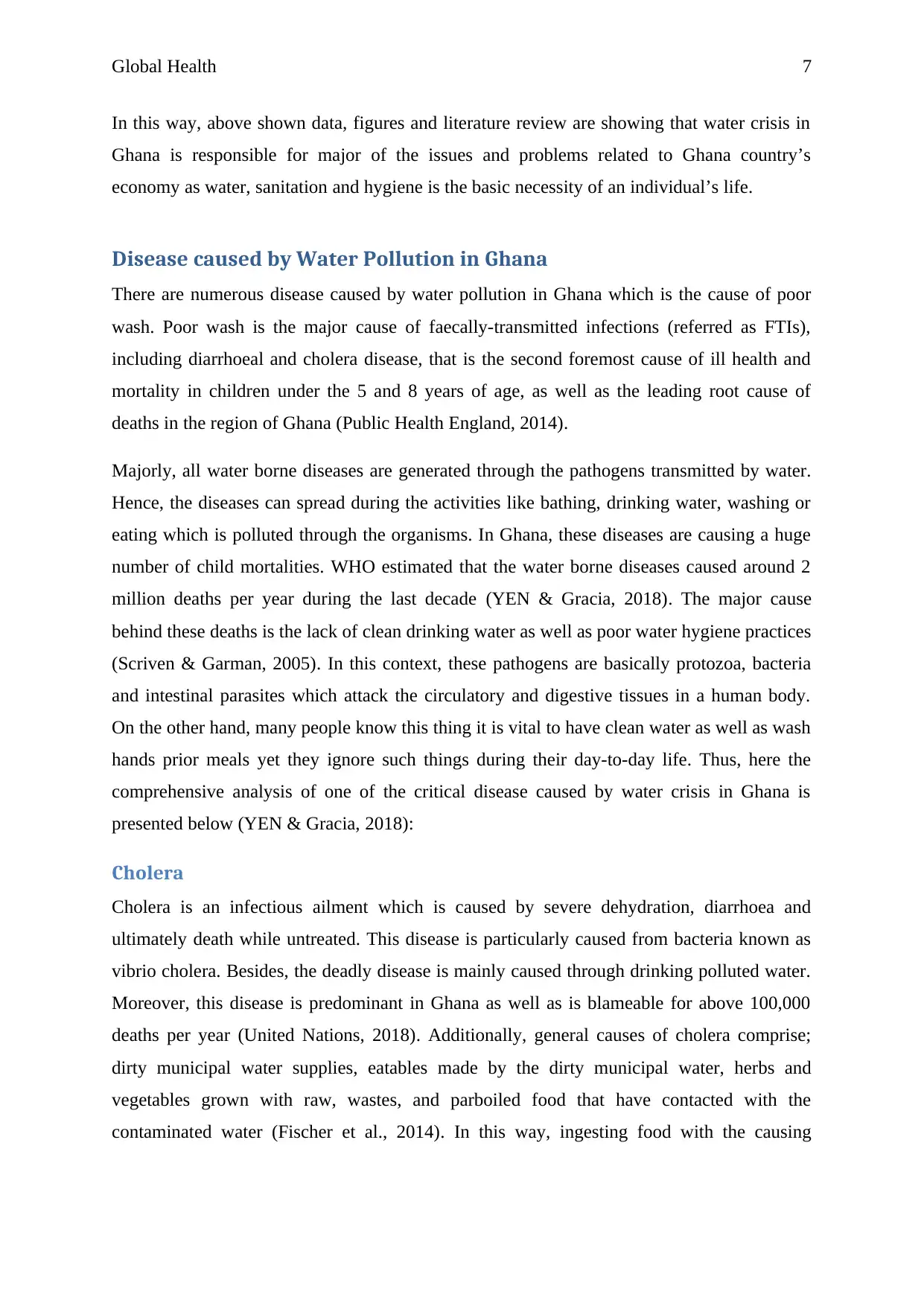
Global Health 7
In this way, above shown data, figures and literature review are showing that water crisis in
Ghana is responsible for major of the issues and problems related to Ghana country’s
economy as water, sanitation and hygiene is the basic necessity of an individual’s life.
Disease caused by Water Pollution in Ghana
There are numerous disease caused by water pollution in Ghana which is the cause of poor
wash. Poor wash is the major cause of faecally-transmitted infections (referred as FTIs),
including diarrhoeal and cholera disease, that is the second foremost cause of ill health and
mortality in children under the 5 and 8 years of age, as well as the leading root cause of
deaths in the region of Ghana (Public Health England, 2014).
Majorly, all water borne diseases are generated through the pathogens transmitted by water.
Hence, the diseases can spread during the activities like bathing, drinking water, washing or
eating which is polluted through the organisms. In Ghana, these diseases are causing a huge
number of child mortalities. WHO estimated that the water borne diseases caused around 2
million deaths per year during the last decade (YEN & Gracia, 2018). The major cause
behind these deaths is the lack of clean drinking water as well as poor water hygiene practices
(Scriven & Garman, 2005). In this context, these pathogens are basically protozoa, bacteria
and intestinal parasites which attack the circulatory and digestive tissues in a human body.
On the other hand, many people know this thing it is vital to have clean water as well as wash
hands prior meals yet they ignore such things during their day-to-day life. Thus, here the
comprehensive analysis of one of the critical disease caused by water crisis in Ghana is
presented below (YEN & Gracia, 2018):
Cholera
Cholera is an infectious ailment which is caused by severe dehydration, diarrhoea and
ultimately death while untreated. This disease is particularly caused from bacteria known as
vibrio cholera. Besides, the deadly disease is mainly caused through drinking polluted water.
Moreover, this disease is predominant in Ghana as well as is blameable for above 100,000
deaths per year (United Nations, 2018). Additionally, general causes of cholera comprise;
dirty municipal water supplies, eatables made by the dirty municipal water, herbs and
vegetables grown with raw, wastes, and parboiled food that have contacted with the
contaminated water (Fischer et al., 2014). In this way, ingesting food with the causing
In this way, above shown data, figures and literature review are showing that water crisis in
Ghana is responsible for major of the issues and problems related to Ghana country’s
economy as water, sanitation and hygiene is the basic necessity of an individual’s life.
Disease caused by Water Pollution in Ghana
There are numerous disease caused by water pollution in Ghana which is the cause of poor
wash. Poor wash is the major cause of faecally-transmitted infections (referred as FTIs),
including diarrhoeal and cholera disease, that is the second foremost cause of ill health and
mortality in children under the 5 and 8 years of age, as well as the leading root cause of
deaths in the region of Ghana (Public Health England, 2014).
Majorly, all water borne diseases are generated through the pathogens transmitted by water.
Hence, the diseases can spread during the activities like bathing, drinking water, washing or
eating which is polluted through the organisms. In Ghana, these diseases are causing a huge
number of child mortalities. WHO estimated that the water borne diseases caused around 2
million deaths per year during the last decade (YEN & Gracia, 2018). The major cause
behind these deaths is the lack of clean drinking water as well as poor water hygiene practices
(Scriven & Garman, 2005). In this context, these pathogens are basically protozoa, bacteria
and intestinal parasites which attack the circulatory and digestive tissues in a human body.
On the other hand, many people know this thing it is vital to have clean water as well as wash
hands prior meals yet they ignore such things during their day-to-day life. Thus, here the
comprehensive analysis of one of the critical disease caused by water crisis in Ghana is
presented below (YEN & Gracia, 2018):
Cholera
Cholera is an infectious ailment which is caused by severe dehydration, diarrhoea and
ultimately death while untreated. This disease is particularly caused from bacteria known as
vibrio cholera. Besides, the deadly disease is mainly caused through drinking polluted water.
Moreover, this disease is predominant in Ghana as well as is blameable for above 100,000
deaths per year (United Nations, 2018). Additionally, general causes of cholera comprise;
dirty municipal water supplies, eatables made by the dirty municipal water, herbs and
vegetables grown with raw, wastes, and parboiled food that have contacted with the
contaminated water (Fischer et al., 2014). In this way, ingesting food with the causing
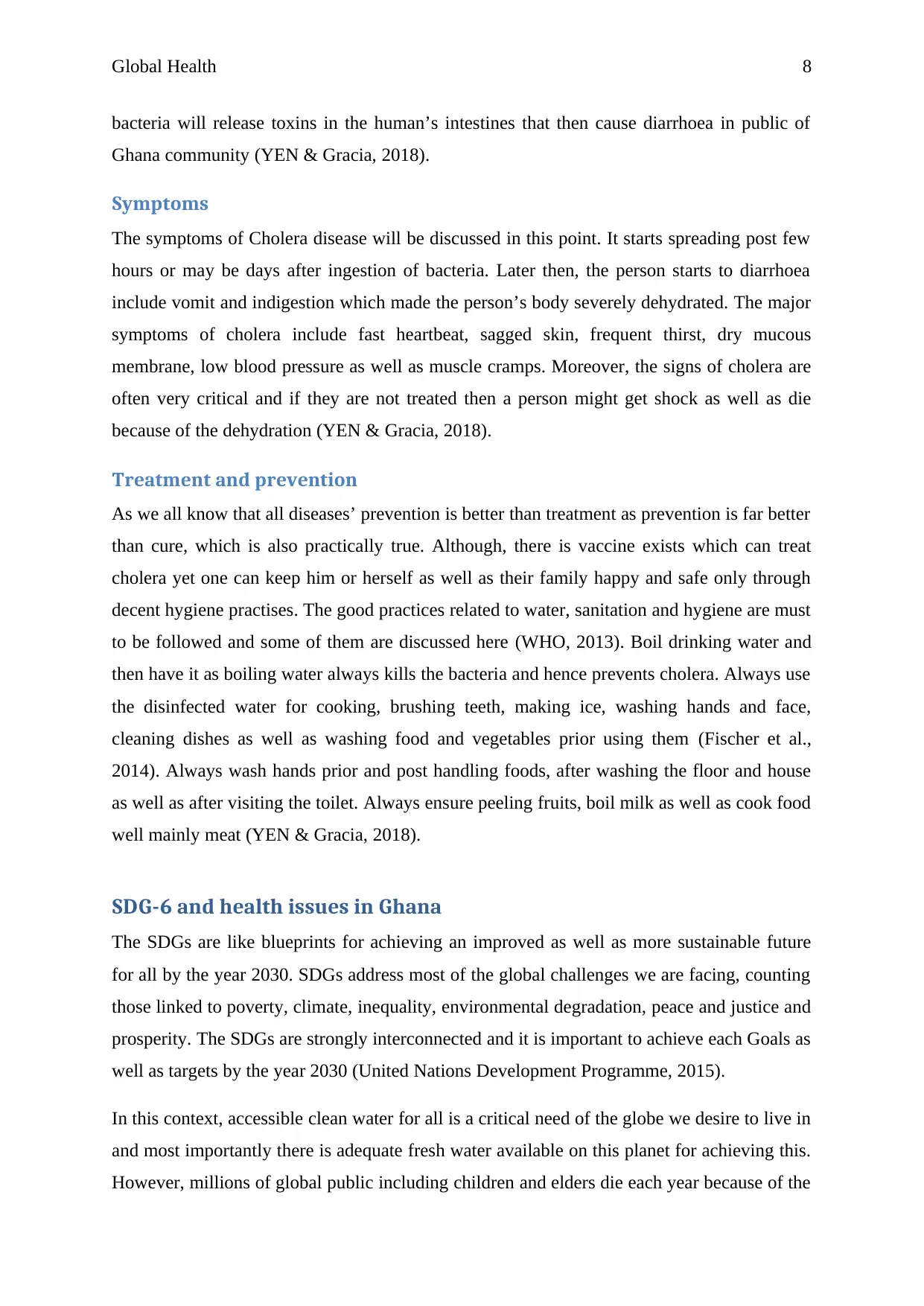
Global Health 8
bacteria will release toxins in the human’s intestines that then cause diarrhoea in public of
Ghana community (YEN & Gracia, 2018).
Symptoms
The symptoms of Cholera disease will be discussed in this point. It starts spreading post few
hours or may be days after ingestion of bacteria. Later then, the person starts to diarrhoea
include vomit and indigestion which made the person’s body severely dehydrated. The major
symptoms of cholera include fast heartbeat, sagged skin, frequent thirst, dry mucous
membrane, low blood pressure as well as muscle cramps. Moreover, the signs of cholera are
often very critical and if they are not treated then a person might get shock as well as die
because of the dehydration (YEN & Gracia, 2018).
Treatment and prevention
As we all know that all diseases’ prevention is better than treatment as prevention is far better
than cure, which is also practically true. Although, there is vaccine exists which can treat
cholera yet one can keep him or herself as well as their family happy and safe only through
decent hygiene practises. The good practices related to water, sanitation and hygiene are must
to be followed and some of them are discussed here (WHO, 2013). Boil drinking water and
then have it as boiling water always kills the bacteria and hence prevents cholera. Always use
the disinfected water for cooking, brushing teeth, making ice, washing hands and face,
cleaning dishes as well as washing food and vegetables prior using them (Fischer et al.,
2014). Always wash hands prior and post handling foods, after washing the floor and house
as well as after visiting the toilet. Always ensure peeling fruits, boil milk as well as cook food
well mainly meat (YEN & Gracia, 2018).
SDG-6 and health issues in Ghana
The SDGs are like blueprints for achieving an improved as well as more sustainable future
for all by the year 2030. SDGs address most of the global challenges we are facing, counting
those linked to poverty, climate, inequality, environmental degradation, peace and justice and
prosperity. The SDGs are strongly interconnected and it is important to achieve each Goals as
well as targets by the year 2030 (United Nations Development Programme, 2015).
In this context, accessible clean water for all is a critical need of the globe we desire to live in
and most importantly there is adequate fresh water available on this planet for achieving this.
However, millions of global public including children and elders die each year because of the
bacteria will release toxins in the human’s intestines that then cause diarrhoea in public of
Ghana community (YEN & Gracia, 2018).
Symptoms
The symptoms of Cholera disease will be discussed in this point. It starts spreading post few
hours or may be days after ingestion of bacteria. Later then, the person starts to diarrhoea
include vomit and indigestion which made the person’s body severely dehydrated. The major
symptoms of cholera include fast heartbeat, sagged skin, frequent thirst, dry mucous
membrane, low blood pressure as well as muscle cramps. Moreover, the signs of cholera are
often very critical and if they are not treated then a person might get shock as well as die
because of the dehydration (YEN & Gracia, 2018).
Treatment and prevention
As we all know that all diseases’ prevention is better than treatment as prevention is far better
than cure, which is also practically true. Although, there is vaccine exists which can treat
cholera yet one can keep him or herself as well as their family happy and safe only through
decent hygiene practises. The good practices related to water, sanitation and hygiene are must
to be followed and some of them are discussed here (WHO, 2013). Boil drinking water and
then have it as boiling water always kills the bacteria and hence prevents cholera. Always use
the disinfected water for cooking, brushing teeth, making ice, washing hands and face,
cleaning dishes as well as washing food and vegetables prior using them (Fischer et al.,
2014). Always wash hands prior and post handling foods, after washing the floor and house
as well as after visiting the toilet. Always ensure peeling fruits, boil milk as well as cook food
well mainly meat (YEN & Gracia, 2018).
SDG-6 and health issues in Ghana
The SDGs are like blueprints for achieving an improved as well as more sustainable future
for all by the year 2030. SDGs address most of the global challenges we are facing, counting
those linked to poverty, climate, inequality, environmental degradation, peace and justice and
prosperity. The SDGs are strongly interconnected and it is important to achieve each Goals as
well as targets by the year 2030 (United Nations Development Programme, 2015).
In this context, accessible clean water for all is a critical need of the globe we desire to live in
and most importantly there is adequate fresh water available on this planet for achieving this.
However, millions of global public including children and elders die each year because of the
⊘ This is a preview!⊘
Do you want full access?
Subscribe today to unlock all pages.

Trusted by 1+ million students worldwide
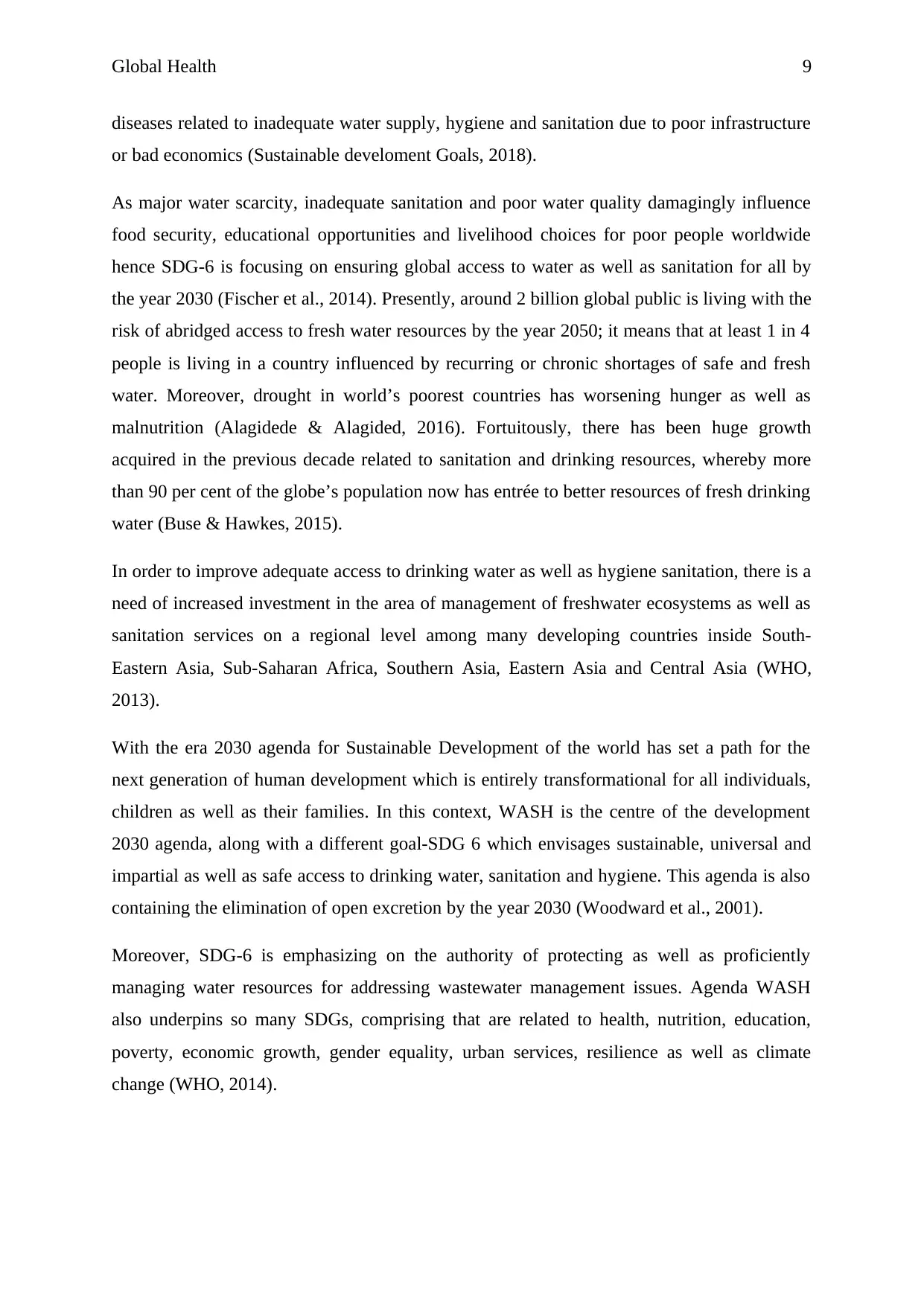
Global Health 9
diseases related to inadequate water supply, hygiene and sanitation due to poor infrastructure
or bad economics (Sustainable develoment Goals, 2018).
As major water scarcity, inadequate sanitation and poor water quality damagingly influence
food security, educational opportunities and livelihood choices for poor people worldwide
hence SDG-6 is focusing on ensuring global access to water as well as sanitation for all by
the year 2030 (Fischer et al., 2014). Presently, around 2 billion global public is living with the
risk of abridged access to fresh water resources by the year 2050; it means that at least 1 in 4
people is living in a country influenced by recurring or chronic shortages of safe and fresh
water. Moreover, drought in world’s poorest countries has worsening hunger as well as
malnutrition (Alagidede & Alagided, 2016). Fortuitously, there has been huge growth
acquired in the previous decade related to sanitation and drinking resources, whereby more
than 90 per cent of the globe’s population now has entrée to better resources of fresh drinking
water (Buse & Hawkes, 2015).
In order to improve adequate access to drinking water as well as hygiene sanitation, there is a
need of increased investment in the area of management of freshwater ecosystems as well as
sanitation services on a regional level among many developing countries inside South-
Eastern Asia, Sub-Saharan Africa, Southern Asia, Eastern Asia and Central Asia (WHO,
2013).
With the era 2030 agenda for Sustainable Development of the world has set a path for the
next generation of human development which is entirely transformational for all individuals,
children as well as their families. In this context, WASH is the centre of the development
2030 agenda, along with a different goal-SDG 6 which envisages sustainable, universal and
impartial as well as safe access to drinking water, sanitation and hygiene. This agenda is also
containing the elimination of open excretion by the year 2030 (Woodward et al., 2001).
Moreover, SDG-6 is emphasizing on the authority of protecting as well as proficiently
managing water resources for addressing wastewater management issues. Agenda WASH
also underpins so many SDGs, comprising that are related to health, nutrition, education,
poverty, economic growth, gender equality, urban services, resilience as well as climate
change (WHO, 2014).
diseases related to inadequate water supply, hygiene and sanitation due to poor infrastructure
or bad economics (Sustainable develoment Goals, 2018).
As major water scarcity, inadequate sanitation and poor water quality damagingly influence
food security, educational opportunities and livelihood choices for poor people worldwide
hence SDG-6 is focusing on ensuring global access to water as well as sanitation for all by
the year 2030 (Fischer et al., 2014). Presently, around 2 billion global public is living with the
risk of abridged access to fresh water resources by the year 2050; it means that at least 1 in 4
people is living in a country influenced by recurring or chronic shortages of safe and fresh
water. Moreover, drought in world’s poorest countries has worsening hunger as well as
malnutrition (Alagidede & Alagided, 2016). Fortuitously, there has been huge growth
acquired in the previous decade related to sanitation and drinking resources, whereby more
than 90 per cent of the globe’s population now has entrée to better resources of fresh drinking
water (Buse & Hawkes, 2015).
In order to improve adequate access to drinking water as well as hygiene sanitation, there is a
need of increased investment in the area of management of freshwater ecosystems as well as
sanitation services on a regional level among many developing countries inside South-
Eastern Asia, Sub-Saharan Africa, Southern Asia, Eastern Asia and Central Asia (WHO,
2013).
With the era 2030 agenda for Sustainable Development of the world has set a path for the
next generation of human development which is entirely transformational for all individuals,
children as well as their families. In this context, WASH is the centre of the development
2030 agenda, along with a different goal-SDG 6 which envisages sustainable, universal and
impartial as well as safe access to drinking water, sanitation and hygiene. This agenda is also
containing the elimination of open excretion by the year 2030 (Woodward et al., 2001).
Moreover, SDG-6 is emphasizing on the authority of protecting as well as proficiently
managing water resources for addressing wastewater management issues. Agenda WASH
also underpins so many SDGs, comprising that are related to health, nutrition, education,
poverty, economic growth, gender equality, urban services, resilience as well as climate
change (WHO, 2014).
Paraphrase This Document
Need a fresh take? Get an instant paraphrase of this document with our AI Paraphraser
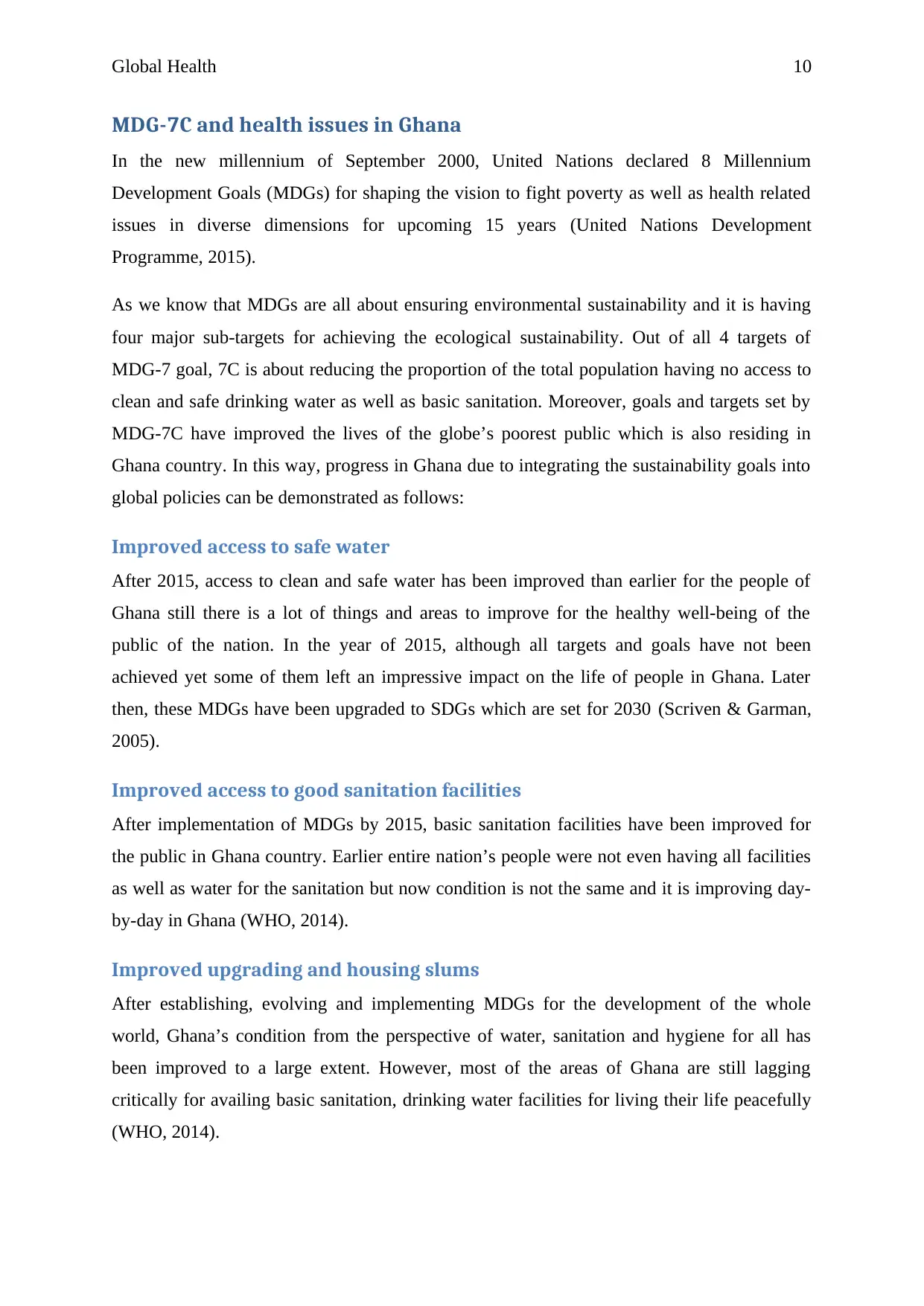
Global Health 10
MDG-7C and health issues in Ghana
In the new millennium of September 2000, United Nations declared 8 Millennium
Development Goals (MDGs) for shaping the vision to fight poverty as well as health related
issues in diverse dimensions for upcoming 15 years (United Nations Development
Programme, 2015).
As we know that MDGs are all about ensuring environmental sustainability and it is having
four major sub-targets for achieving the ecological sustainability. Out of all 4 targets of
MDG-7 goal, 7C is about reducing the proportion of the total population having no access to
clean and safe drinking water as well as basic sanitation. Moreover, goals and targets set by
MDG-7C have improved the lives of the globe’s poorest public which is also residing in
Ghana country. In this way, progress in Ghana due to integrating the sustainability goals into
global policies can be demonstrated as follows:
Improved access to safe water
After 2015, access to clean and safe water has been improved than earlier for the people of
Ghana still there is a lot of things and areas to improve for the healthy well-being of the
public of the nation. In the year of 2015, although all targets and goals have not been
achieved yet some of them left an impressive impact on the life of people in Ghana. Later
then, these MDGs have been upgraded to SDGs which are set for 2030 (Scriven & Garman,
2005).
Improved access to good sanitation facilities
After implementation of MDGs by 2015, basic sanitation facilities have been improved for
the public in Ghana country. Earlier entire nation’s people were not even having all facilities
as well as water for the sanitation but now condition is not the same and it is improving day-
by-day in Ghana (WHO, 2014).
Improved upgrading and housing slums
After establishing, evolving and implementing MDGs for the development of the whole
world, Ghana’s condition from the perspective of water, sanitation and hygiene for all has
been improved to a large extent. However, most of the areas of Ghana are still lagging
critically for availing basic sanitation, drinking water facilities for living their life peacefully
(WHO, 2014).
MDG-7C and health issues in Ghana
In the new millennium of September 2000, United Nations declared 8 Millennium
Development Goals (MDGs) for shaping the vision to fight poverty as well as health related
issues in diverse dimensions for upcoming 15 years (United Nations Development
Programme, 2015).
As we know that MDGs are all about ensuring environmental sustainability and it is having
four major sub-targets for achieving the ecological sustainability. Out of all 4 targets of
MDG-7 goal, 7C is about reducing the proportion of the total population having no access to
clean and safe drinking water as well as basic sanitation. Moreover, goals and targets set by
MDG-7C have improved the lives of the globe’s poorest public which is also residing in
Ghana country. In this way, progress in Ghana due to integrating the sustainability goals into
global policies can be demonstrated as follows:
Improved access to safe water
After 2015, access to clean and safe water has been improved than earlier for the people of
Ghana still there is a lot of things and areas to improve for the healthy well-being of the
public of the nation. In the year of 2015, although all targets and goals have not been
achieved yet some of them left an impressive impact on the life of people in Ghana. Later
then, these MDGs have been upgraded to SDGs which are set for 2030 (Scriven & Garman,
2005).
Improved access to good sanitation facilities
After implementation of MDGs by 2015, basic sanitation facilities have been improved for
the public in Ghana country. Earlier entire nation’s people were not even having all facilities
as well as water for the sanitation but now condition is not the same and it is improving day-
by-day in Ghana (WHO, 2014).
Improved upgrading and housing slums
After establishing, evolving and implementing MDGs for the development of the whole
world, Ghana’s condition from the perspective of water, sanitation and hygiene for all has
been improved to a large extent. However, most of the areas of Ghana are still lagging
critically for availing basic sanitation, drinking water facilities for living their life peacefully
(WHO, 2014).
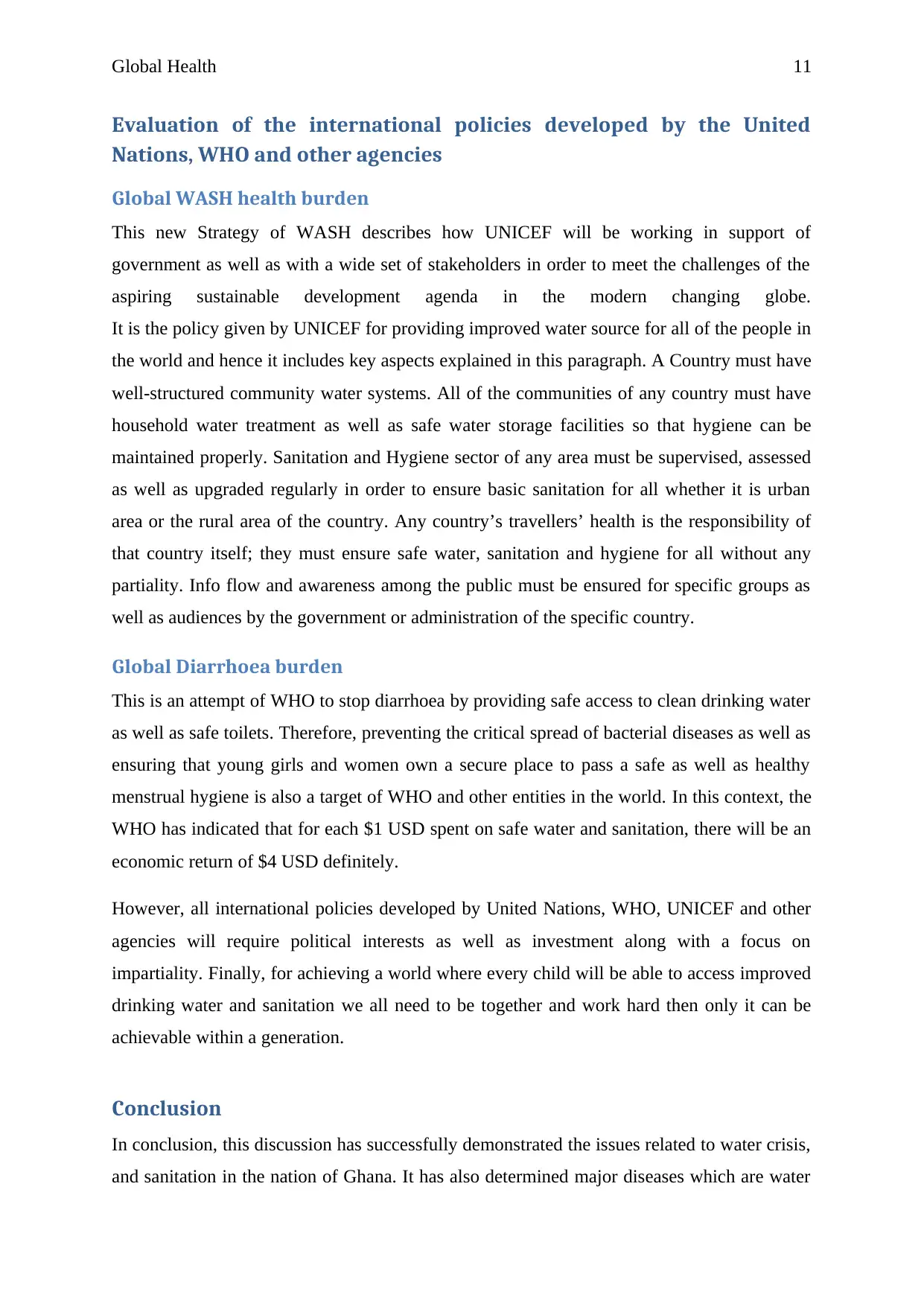
Global Health 11
Evaluation of the international policies developed by the United
Nations, WHO and other agencies
Global WASH health burden
This new Strategy of WASH describes how UNICEF will be working in support of
government as well as with a wide set of stakeholders in order to meet the challenges of the
aspiring sustainable development agenda in the modern changing globe.
It is the policy given by UNICEF for providing improved water source for all of the people in
the world and hence it includes key aspects explained in this paragraph. A Country must have
well-structured community water systems. All of the communities of any country must have
household water treatment as well as safe water storage facilities so that hygiene can be
maintained properly. Sanitation and Hygiene sector of any area must be supervised, assessed
as well as upgraded regularly in order to ensure basic sanitation for all whether it is urban
area or the rural area of the country. Any country’s travellers’ health is the responsibility of
that country itself; they must ensure safe water, sanitation and hygiene for all without any
partiality. Info flow and awareness among the public must be ensured for specific groups as
well as audiences by the government or administration of the specific country.
Global Diarrhoea burden
This is an attempt of WHO to stop diarrhoea by providing safe access to clean drinking water
as well as safe toilets. Therefore, preventing the critical spread of bacterial diseases as well as
ensuring that young girls and women own a secure place to pass a safe as well as healthy
menstrual hygiene is also a target of WHO and other entities in the world. In this context, the
WHO has indicated that for each $1 USD spent on safe water and sanitation, there will be an
economic return of $4 USD definitely.
However, all international policies developed by United Nations, WHO, UNICEF and other
agencies will require political interests as well as investment along with a focus on
impartiality. Finally, for achieving a world where every child will be able to access improved
drinking water and sanitation we all need to be together and work hard then only it can be
achievable within a generation.
Conclusion
In conclusion, this discussion has successfully demonstrated the issues related to water crisis,
and sanitation in the nation of Ghana. It has also determined major diseases which are water
Evaluation of the international policies developed by the United
Nations, WHO and other agencies
Global WASH health burden
This new Strategy of WASH describes how UNICEF will be working in support of
government as well as with a wide set of stakeholders in order to meet the challenges of the
aspiring sustainable development agenda in the modern changing globe.
It is the policy given by UNICEF for providing improved water source for all of the people in
the world and hence it includes key aspects explained in this paragraph. A Country must have
well-structured community water systems. All of the communities of any country must have
household water treatment as well as safe water storage facilities so that hygiene can be
maintained properly. Sanitation and Hygiene sector of any area must be supervised, assessed
as well as upgraded regularly in order to ensure basic sanitation for all whether it is urban
area or the rural area of the country. Any country’s travellers’ health is the responsibility of
that country itself; they must ensure safe water, sanitation and hygiene for all without any
partiality. Info flow and awareness among the public must be ensured for specific groups as
well as audiences by the government or administration of the specific country.
Global Diarrhoea burden
This is an attempt of WHO to stop diarrhoea by providing safe access to clean drinking water
as well as safe toilets. Therefore, preventing the critical spread of bacterial diseases as well as
ensuring that young girls and women own a secure place to pass a safe as well as healthy
menstrual hygiene is also a target of WHO and other entities in the world. In this context, the
WHO has indicated that for each $1 USD spent on safe water and sanitation, there will be an
economic return of $4 USD definitely.
However, all international policies developed by United Nations, WHO, UNICEF and other
agencies will require political interests as well as investment along with a focus on
impartiality. Finally, for achieving a world where every child will be able to access improved
drinking water and sanitation we all need to be together and work hard then only it can be
achievable within a generation.
Conclusion
In conclusion, this discussion has successfully demonstrated the issues related to water crisis,
and sanitation in the nation of Ghana. It has also determined major diseases which are water
⊘ This is a preview!⊘
Do you want full access?
Subscribe today to unlock all pages.

Trusted by 1+ million students worldwide
1 out of 17
Related Documents
Your All-in-One AI-Powered Toolkit for Academic Success.
+13062052269
info@desklib.com
Available 24*7 on WhatsApp / Email
![[object Object]](/_next/static/media/star-bottom.7253800d.svg)
Unlock your academic potential
Copyright © 2020–2025 A2Z Services. All Rights Reserved. Developed and managed by ZUCOL.





